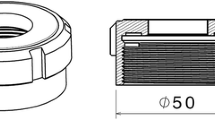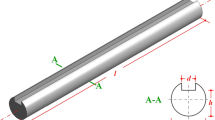The process of quenching of a Navy C-ring specimen from steel AISI 4140 is simulated with the help of the DANTE software for determining the effect of stirring of the quenching medium and of the quenching temperature on the distortion of the specimen. The heat transfer coefficients (KT) of the quenching medium at different intensities of its stirring are determined experimentally with the use of a CHTE probe for controlling the heat treatment parameters of metallic materials. The experimental data agree well with the simulation results.












Similar content being viewed by others
References
H. W. Zach, “Materialwissenschaft und Werkstofftechnik: Entwicklung, Fertigung,” Prüfung, Eigenschaften und Anwendungen technischer Werkstoffe, 40(5–6), 342 (2009).
L. D. C. F. Canale and G. E. Totten, Mater. Res., 8(4), 461 (2005).
J. Moyer and G. Ansell, Metall. Trans. A, 6(9), 1785 (1975).
F. Frerichs, T. Lübben, F. Hoffman, and H. W. Zach, Materialwiss. Werkstoff., 43(1–2), 16 (2012).
M. Jung, M. Kang, and Y. K. Lee, Acta Mater., 60(2), 525 (2012).
C. Şimşir and C. H. Gür, J. Mater. Proc. Technol., 07(1–3), 211 (2008).
S. J. Lee and Y. K. Lee, Acta Mater., 56(7), 1482 (2008).
Z. Li, B. V. Grandhi, and R. Srinivasan, J. Mater. Proc. Technol., 172(2), 249 (2006).
R. Atraszkiewicz, R. Januszewicz, W. Stachurski, et al., Mater. Sci. Eng. A, 58, 550 (2012).
B. Clausen, F. Frerichs, T. Kohlhoff, et al., “Materialwissenschaft und Werkstofftechnik: Entwicklung, Fertigung,” Prüfung, Eigenschaften und Anwendungen technischer Werkstoffe, 40(56), 361 (2009).
G. E. Totten, Handbook of Residual Stresses and Deformation of Steel, ASM Int. (2002).
A. Da Silva, T. Pedrosa, J. Gonzalez-Mendez et. al., Mater. Design, 42, 55 (2012).
J. Li, H. Zhang, et al., J. Mater. Eng. Perform., 23(12), 4237 (2014).
H. Farivar, U. Prahl, M. Hans, and W. Bleck, J. Mater. Proc. Technol., 264, 313 (2019).
C. Nan, D. Northwood, R. Bowers, et al., WIT Trans. Eng. Sci., 62, 13 (2009).
M. Maniruzzaman, J. Charves, C. McGee Jr. et al., in: 5th Int. Conf. on Frontiers Design and Manufacturing (ICFDM) (2002), pp. 619 – 625.
B. L. Ferguson, Z. Li, and A. Freborg, Comp. Mater. Sci., 34(3), 274 (2005).
A. F. Mills, Heat Transfer, Prentice Hall, Upper Saddle River, NJ (1999).
https://www.forestry-uppliers.com/productpages/products.php?mi=33981&itemnum=
H. Yu, Y. Lu, Y. Xu, and R. Sisson, in: 100 Years of E04 Development of Metallography Standards, ASTM Int. (2019).
H. Rietveld, J. Appl. Crystallogr., 2(2), 65 (1969).
H. Retveld, Acta Crystallogr., 22(1), 151 (1967).
Y. Lu, H. Yu, and R. D. Sisson Jr, Mater. Sci. Eng. A, 700, 592 (2017).
The work has been supported by the Center for Heat Treating Excellence (CHTE). The authors acknowledge the concern of all the members of the CHTE. Special thanks to Olga Rowan and Monhammed Maniruzzaman from the Caterpillar Inc. for the help with the quenching tests and to Justin Smith and Charlie Li from Dante-Solution for valuable suggestions.
Author information
Authors and Affiliations
Corresponding author
Additional information
Translated from Metallovedenie i Termicheskaya Obrabotka Metallov, No. 4, pp. 52 – 61, April, 2021.
Rights and permissions
About this article
Cite this article
Yu, H., Yang, M. & Sisson, R.D. Application of C-Ring Specimen for Controlling the Distortion of Parts During Quenching. Met Sci Heat Treat 63, 220–228 (2021). https://doi.org/10.1007/s11041-021-00674-w
Published:
Issue Date:
DOI: https://doi.org/10.1007/s11041-021-00674-w




